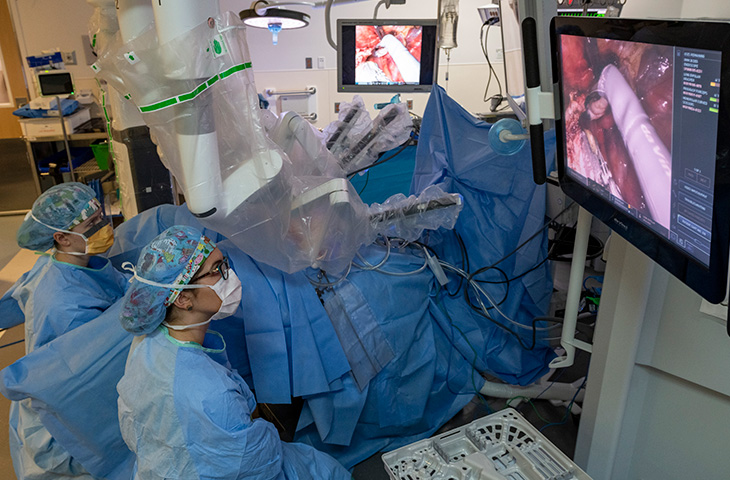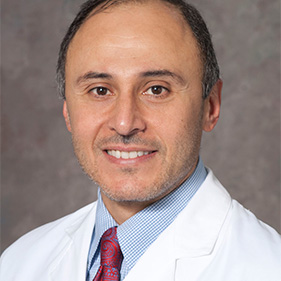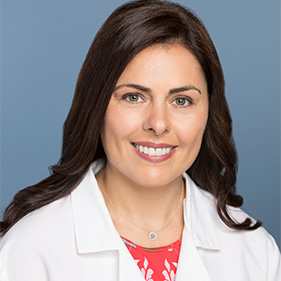UC Davis Medical Center celebrates 20 years of robotic surgery
This year, UC Davis Health is celebrating 20 years of offering patients minimally invasive robot-assisted surgery. With this milestone, the health system continues to be a leader in robotic surgery while offering patients unmatched minimally invasive, quality surgical care.
UC Davis Health was an early adopter of robotic surgery. The first robotic procedure performed at the medical center was a Roux-en-Y gastric bypass in October 2002 with the Zeus robot. It was the first robotic surgery procedure in the Sacramento region and the start to one of the earliest robotic bariatric surgery programs in the country.
“Reaching this monumental achievement at UC Davis Health is a wonderful reminder of each of the patients treated and the lives touched over the last 20 years,” said Mohamed R. Ali, chief of foregut, metabolic and general Surgery, who performed the first robotic procedure at UC Davis Health. “What we’ve been able to accomplish over the last two decades in robotic surgery has set a standard in this field, and it has been tremendously rewarding to be a part of the team of faculty and staff who have achieved this milestone.”
What we’ve been able to accomplish over the last two decades in robotic surgery has set a standard in this field, and it has been tremendously rewarding to be a part of the team of faculty and staff who have achieved this milestone.” —Mohamed R. Ali
Leading the way
Over the last two decades, UC Davis Health has become a leader in the field of robotic surgery and has been at the forefront of defining and refining the best uses and techniques for the practice. Some of the department's accomplishments include:
- Being designated as a training center for the American Association for Thoracic Surgery Foundation’s Cardiac Surgical Robotics Program, the first such center in California and just the sixth in the United States.
- Performing the first single-anesthesia diagnosis to treatment of lung cancer using a fully robotic approach in the UC Health System.
- Becoming the only hospital in the region to offer cardiothoracic robotic surgery.
- Adopting low pressure insufflation as the standard for all surgical laparoscopic procedures, utilizing ConMed's AirSeal® System. The medical center was the first multi-site health system in the nation to implement the practice systemwide.
- Being one of the first health systems to publish on how to teach robotic surgery and working with Intuitive to develop the tele illustration system which is still used today.
- Cutting the median length of stay for lung cancer patients in half from four days to just two days, with over 20% of patients going home the next day after surgery.
- Elevating and modernizing the cranial robotics program's approach to stereotactic brain surgery, which includes the use of a new state-of-the-art gamma knife that uses radiation to perform brain surgery without a scalpel.
- Performing the first fully robotic nephrectomy on a living donor in the Sacramento region.
- Becoming the first health system to offer a comprehensive robotic neurosurgery program in the region.
- Integrating a novel imaging technology with robotic surgical systems to help detect primary cancerous tissue during head and neck cancer surgeries.
“The application of these next-generation technologies underscores our commitment to innovation and excellence in patient care,” said Bahareh Nejad, medical director of robotic surgery. “The institutional support we have received to grow the UC Davis Robotics Program has allowed us to provide novel approaches to patient care, leading to more minimally invasive surgeries. We look forward to continuing to push the envelope of patient care and support further expansion of our robotic surgery program.”

Benefits of robotic surgery
UC Davis Medical Center offers minimally invasive, robotic-assisted surgical procedures across 17 medical disciplines, which include:
- gastrointestinal
- cardiac
- general thoracic
- gynecologic oncology
- otolaryngology
- urologic
- orthopaedic
- transplant surgery
Each procedure is performed by a highly experienced and skilled team of surgeons, nurses and technicians who are specially trained to use robotic surgical systems. These include the medical center's nine surgical robots: four daVinci XI dual console robots, two Ion Endoluminal Platform by Intuitive, Da Vinci SP (single port), ExcelsiusGPS® Robotic Navigation Platform by Globus and the Stryker Mako SmartRobotics system.
For surgeons, robotic systems provide improved, 3D visualization and precision control of surgical instruments. The technology can be ideal for certain delicate or complex surgeries because it makes it easier for surgeons to avoid surrounding nerves and organs.
“Advanced robotics is revolutionizing minimally invasive cardiac surgery for both the patient and the physician,” said Bob Kiaii, chief of Cardiothoracic Surgery. “The robot overcomes the limitations of traditional technology and allows the surgeon to have all the degrees of freedom of her or his hands to be more efficient and accurate during procedures.”
For patients, robotic surgery offers several potential benefits over conventional open surgery, including:
- Less pain and use of pain medication
- Less blood loss
- Less risk of infection
- Less scarring
- Shorter hospital stays
- Shorter recovery time
“The advantage of this approach lies in its safety as the smaller incisions, combined with greater precision, help reduce pain and scarring, which ultimately leads to quicker recovery, less time in the hospital, and a faster return to home and a normal life for our patients,” explained David Tom Cooke, founding chief of General Thoracic Surgery.
Training the next generation
As the region’s only academic medical center, UC Davis Health is committed to safely training the next generation of surgeons to perform robotic surgery.
Each surgical robot at the medical center has dual consoles, which allows for residents or fellows to train with a faculty member during a procedure. Robotic surgery has also created a simulator room that is open 24 hours per day, 365 days a year for faculty and staff to train in new techniques or warm-up for procedures in a low stress environment.
In addition, the department brings in a mobile robot training system for two weeks, twice a year, to train residents and all staff, including nurses, to use the double console robots.
UC Davis Health has positioned itself as a leader in robotic surgery by being the first in so many areas, including training the next generation of robotic surgeons. Not only are we pushing the envelope on performing new procedures, but we are also training in all of them.”—Bahareh Nejad
“UC Davis Health has positioned itself as a leader in robotic surgery by being the first in so many areas — including training the next generation of robotic surgeons,” Nejad said. “Not only are we pushing the envelope on performing new procedures, but we are also training in all of them.”
Within Aggie Square, the emerging innovation district on the UC Davis Health campus that is expected to be completed in the first quarter of 2025, one of the rooms will be predominantly dedicated to robotic surgical training.
Once the space is built, medical students, residents, fellows, staff and international colleagues will be able to observe and perform robotic surgery on high fidelity models, using the same equipment that they would encounter in the operating room. Industry partners will also have room to reveal new and innovative technology.
“We are always looking for the latest technology and training techniques to implement,” added Nejad. “Investing in this type of innovative robotic training technology demonstrates our dedication to quality and patient-centered health care.”





